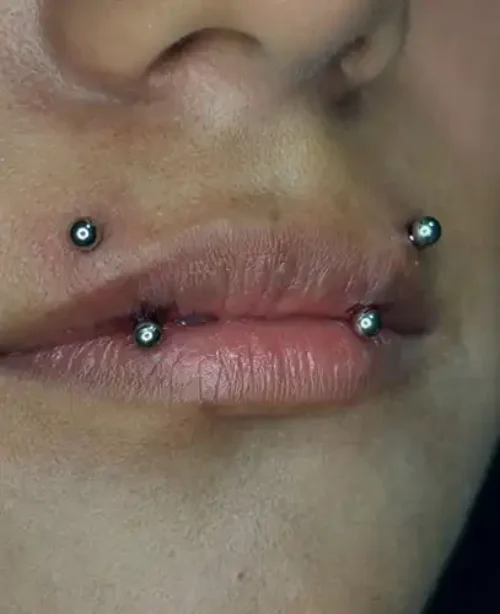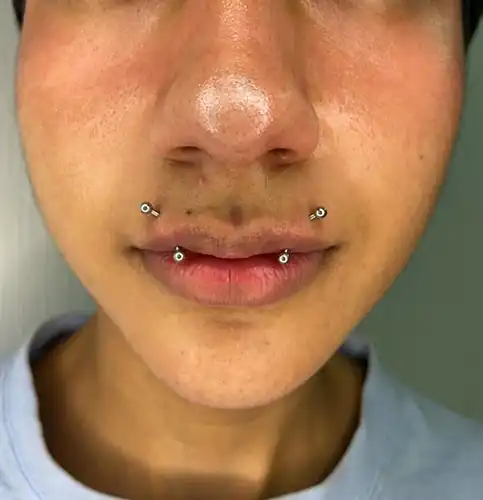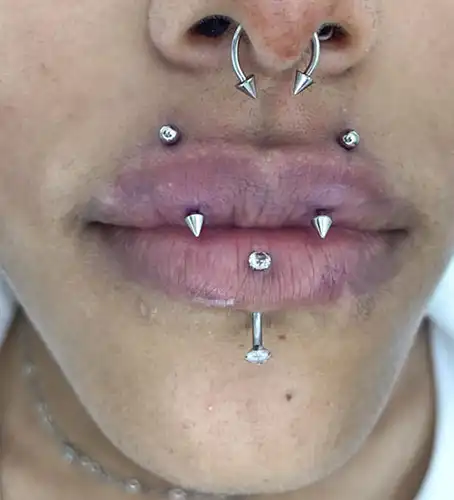Angel Bites Piercing in Nairobi, Kenya
This piercing involves two symmetrical piercings on the upper lip, placed on either side of the philtrum, which is the vertical groove in the middle area of the upper lip. The name “Angel Bites” comes from the idea that these piercings resemble the marks of an angel’s bite.

Angel Bites Piercing
Angel Bites Piercing Procedure
Getting Angel Bites piercings involves several steps to ensure the process is safe and hygienic. Here’s a general outline of what to expect:
- Choosing a Professional Piercer:
– Research and choose a reputable, experienced piercer with positive reviews and detailed portfolio.
– Ensure the piercing studio follows strict hygiene and sterilization protocols. - Consultation:
– Discuss your desired look and placement with our piercer.
– Our piercer will evaluate your anatomy to determine the best placement.
– Ask any questions you have about the procedure, aftercare, and healing process. - Preparation:
– Our piercer will clean and disinfect the area around your upper lip.
– They will mark the exact spots where the piercings will be placed for your approval.
– You may be asked to rinse your mouth with an antiseptic mouthwash to minimize bacteria. - Piercing Procedure:
– You will be asked to sit or lie down in a comfortable position.
– Our piercer will use a sterilized needle to create the first piercing, inserting it through the marked spot on one side of your upper lip.
– They will then insert the jewelry (usually a labret stud or a small ring) into the fresh piercing.
– The process will be repeated for the second piercing on the other side of your upper lip. - Aftercare Instructions:
– Our piercer will provide detailed aftercare instructions, which typically include:
– Cleaning the piercings with a saline solution or an antiseptic solution recommended by our piercer.
– Avoiding touching the piercings with dirty hands.
– Steering clear of certain foods and drinks that might irritate the piercings.
– Avoiding smoking and alcohol, as they can impede healing.
– Not changing the jewelry until the piercings are fully healed, which can take several weeks to months. - Healing and Follow-Up:
– Healing time for Angel Bites can vary but usually takes 6-8 weeks.
– Monitor the piercings for any signs of infection, such as excessive redness, swelling, pain, or discharge.
– Schedule follow-up visits with our piercer to check the healing progress and address any concerns.
Considerations before getting a Angel Bites Piercing
Before getting Angel Bites piercings, there are several important considerations to take into account:
- Pain Tolerance: Lip piercings can be painful due to the sensitivity of the area. Consider your pain tolerance and preparedness for the initial discomfort and healing process.
- Healing Time and Aftercare:
– Healing can take 6-8 weeks or longer. Be ready for a commitment to daily aftercare, including cleaning the piercings with saline solution and avoiding activities that could introduce bacteria or cause irritation.
– Proper aftercare is crucial to avoid infections and complications. - Lifestyle Impact:
– Consider how the piercings will impact your daily activities, such as eating, drinking, and speaking. You may need to avoid certain foods and beverages and be cautious with oral hygiene.
– If you play wind instruments or engage in activities that involve your mouth, these piercings might pose challenges. - Professional Environment: Some workplaces or schools may have policies against visible facial piercings. Consider how the piercings might affect your professional or educational environment.
- Cost:
– The cost of the piercings includes the initial procedure and high-quality jewelry, as well as potential follow-up appointments or treatments if complications arise.
– Quality jewelry and a reputable piercer can be more expensive but are worth the investment for safety and aesthetics. - Allergies and Sensitivities:
– Make sure you’re not allergic to the metals used in the jewelry. Titanium or surgical steel are good options for those with metal sensitivities.
– Discuss any known allergies or skin sensitivities with our piercer. - Potential for Scarring: All piercings have the potential to leave scars if you decide to remove them in the future. Consider whether you’re comfortable with the possibility of permanent marks.
- Risk of Infection: Despite careful aftercare, there’s always a risk of infection. Be aware of the signs of infection, such as excessive redness, swelling, pain, or discharge, and be prepared to seek medical attention if needed.
- Oral Health:
– Piercings in the lip area can affect your teeth and gums. Jewelry can rub against your gums and teeth, potentially causing gum recession or enamel wear over time.
– Maintain good oral hygiene and visit your dentist regularly to monitor any potential issues. - Personal Commitment: Be prepared for the commitment required to care for new piercings. Neglecting aftercare can lead to complications and prolonged healing times.
Carefully considering these factors and discussing any concerns with a professional piercer, you can make an informed decision about whether Angel Bites piercings are right for you.
Angel Bites Piercing Pain and Healing
Pain Level
- Pain During the Procedure:
– Intensity: The pain experienced during the piercing procedure varies from person to person. Generally, people describe the pain as a sharp, quick pinch.
Factors Influencing Pain:
– Individual Pain Tolerance: Those with higher pain tolerance may find the procedure more manageable.
– Experience of the Piercer: A skilled piercer can perform the procedure quickly and efficiently, potentially reducing pain. At Rebel Inks Tattoos, Tattoo Removal, and Body Piercings we have a team of professional and experienced piercers that offer quick and efficient piercing.
– Location and Thickness of Lips: Thicker lips or specific anatomical features can influence pain levels. - Pain After the Procedure:
– Initial Soreness: Expect some soreness, swelling, and tenderness around the pierced area for a few days.
– Managing Pain: Over-the-counter pain relievers like ibuprofen can help manage discomfort. Ice packs can also reduce swelling.
Healing Process
- Healing Time:
– Typical Duration: Angel Bites piercings generally take about 6-8 weeks to heal. Complete healing can take several months, depending on individual healing rates and aftercare practices.
Healing Stages:
– Initial Phase (First Few Days): Swelling and tenderness are common. The body starts to form a protective layer around the jewelry.
– Mid-Healing (2-4 Weeks): Swelling reduces, and the piercing begins to settle. The risk of infection remains, so diligent aftercare is crucial.
– Final Healing (6-8 Weeks): The piercing continues to heal internally. It’s essential to follow aftercare guidelines until fully healed.
Angel Bites Piercing Aftercare
Proper aftercare is crucial for ensuring your Angel Bites piercings heal smoothly and without complications. Here are detailed aftercare instructions:
Cleaning the Piercings
- Saline Solution Soaks:
– Frequency: Clean your piercings twice a day.
– How to Prepare: Use a pre-made saline solution or mix 1/4 teaspoon of non-iodized sea salt with 8 ounces of warm distilled water.
– Application: Soak a clean cotton ball or gauze pad in the solution and gently apply it to the piercing for 5-10 minutes. Alternatively, you can use a saline spray specifically designed for piercings. - Rinsing the Mouth:
– Mouthwash: Use an alcohol-free, antiseptic mouthwash to rinse your mouth after eating or drinking. Do this 2-3 times a day to reduce bacteria.
-Hydration: Drink plenty of water to help flush out your system and keep your mouth clean.
General Hygiene
- Hand Hygiene:
– Before Touching: Always wash your hands thoroughly with soap and water before touching or cleaning your piercings.
– Avoid Unnecessary Contact: Minimize touching the piercings to prevent introducing bacteria. - Oral Hygiene:
– Brushing: Brush your teeth gently twice a day with a soft-bristled toothbrush. Be careful around the piercing sites.
– Flossing: Continue flossing regularly, but do so gently to avoid irritating the piercings.
Lifestyle Adjustments
- Dietary Considerations:
– Avoid Irritants: Stay away from spicy, acidic, salty, or hot foods that can irritate the piercings.
– Soft Foods: Opt for soft foods like yogurt, smoothies, and mashed potatoes during the initial healing phase. - Avoiding Harmful Substances:
– Smoking: Avoid smoking, as it can introduce bacteria and delay healing.
– Alcohol: Refrain from consuming alcohol, especially beer and other drinks that can cause irritation. - Physical Activity:
– Protection: Be cautious during physical activities that could bump or stress the piercings.
– Rest: Ensure you get plenty of rest to support your body’s healing process.
Monitoring and Handling Issues
- Signs of Infection:
– Red Flags: Look out for excessive redness, swelling, pain, yellow or green discharge, or a foul odor.
– Action: If you notice any signs of infection, contact your piercer or a healthcare professional promptly. - Swelling Management: Ice Packs: Use ice packs or cold compresses to reduce swelling during the first few days. Do not apply ice directly to the skin; wrap it in a clean cloth.
- Jewelry Care:
– Avoid Changing Jewelry: Do not attempt to change the jewelry until the piercings are fully healed (6-8 weeks or longer). If you need to change it, consult your piercer.
– Check for Tightness: Ensure the jewelry is neither too tight nor too loose. Tight jewelry can cause irritation, while loose jewelry can get caught on things.
Follow-Up
- Regular Check-Ins:
– Piercer Visits: Schedule follow-up visits with your piercer to check the healing progress and address any concerns.
– Self-Check: Regularly inspect your piercings for any signs of complications or irritation.
By following these aftercare instructions diligently, you can help ensure that your Angel Bites piercings heal properly and remain healthy. If you have any doubts or issues during the healing process, don’t hesitate to consult with your piercer or a healthcare professional.
Angel Bites Piercing Jewelry
Initial Jewelry
- Material:
– Titanium: Hypoallergenic, lightweight, and ideal for those with metal sensitivities.
– Surgical Steel: Commonly used and safe for most people, but may cause reactions in those with nickel allergies.
– Niobium: Another hypoallergenic option, though less common.
– Gold: Only 14k or higher; avoid gold-plated jewelry during the initial healing period. - Type:
– Curved Barbells: Curved back and a post with a ball or decorative end. Ideal for initial piercings due to their secure fit and minimal movement.
– Captive Bead Rings (CBRs): A ring with a removable bead that holds the ring closed. These can move more and may be less comfortable during the initial healing phase. - Size:
– Gauge: Typically 16g or 18g for lip piercings, but consult your piercer for the best size.
– Length/Diameter: The initial jewelry should be slightly longer or have a larger diameter to accommodate swelling. Once healed, you can switch to a more snug fit.
After Healing
- Material Options:
– Solid Gold: 14k or higher, ideal for those wanting a luxurious look without compromising on safety.
– Bioplast or PTFE: Flexible, biocompatible plastics that are gentle on the skin and can reduce irritation. - Jewelry Types:
– Curved Barbells: Still a popular choice for healed piercings, with a variety of decorative ends (gems, shapes, etc.).
– Rings: Once healed, you can opt for seamless rings, segment rings, or clickers for a different look.
– Circular Barbells: Horseshoe-shaped rings that can add a unique flair. - Customization:
– Decorative Ends: Various designs, such as gemstones, spikes, or unique shapes, allow for personalization.
– Colors and Finishes: Anodized titanium or niobium can come in different colors. Gold jewelry can also come in different shades like rose gold or white gold.
Maintenance and Considerations
- Quality: Invest in high-quality jewelry from reputable brands or piercers to avoid complications such as irritation or allergic reactions.
- Fit: Ensure the jewelry fits well and isn’t too tight or too loose. Ill-fitting jewelry can cause discomfort, migration, or rejection.
- Changing Jewelry:
– Wait until your piercings are fully healed before changing the jewelry. If unsure, consult your piercer.
– When changing jewelry, always wash your hands thoroughly and use clean tools to avoid introducing bacteria. - Cleaning: Regularly clean your jewelry with a saline solution or a mild soap and water. Avoid harsh chemicals that can damage the jewelry or irritate the skin.
Professional Advice
- Always consult with our piercer when selecting initial jewelry and for recommendations on safe, high-quality options for after healing.
- Follow our piercer’s advice on the best materials and sizes for your specific anatomy and lifestyle.
Choosing the right jewelry and maintaining proper care, you can ensure that your Angel Bites piercings remain healthy, comfortable, and stylish.
Cost of a Angel Bites Piercing in Nairobi, Kenya
The cost of Angel Bites piercings can vary based on several factors, including the location of the piercing studio, the experience of the piercer, and the quality of the jewelry used. Here’s a breakdown of what you might expect to pay:
General Cost Range
- Basic Piercing Fee:
– Average Cost: The cost for getting both piercings (one on each side of the upper lip) typically costs Ksh. 3,000. This price usually includes the procedure for both piercings.
– Variation by Location: Prices can be higher in larger cities or more upscale studios. - Jewelry Cost:
Standard Jewelry: Basic titanium or surgical steel jewelry is often included in the piercing fee. If not, it can cost an additional .
Upgraded Jewelry: Higher-end materials like gold or jewelry with decorative ends can cost significantly more.
Additional Costs
- Aftercare Products:
Saline Solution: Pre-made saline solution for cleaning the piercings.
Antiseptic Mouthwash: Alcohol-free mouthwash - Follow-Up Appointments:
– Check-Ups: At Rebel Inks Tattoos, Tattoo Removal, and Body Piercings Parlour we at times include follow-up visits in the initial cost, otherwise, when not included we may charge a small fee (Ksh. 300 to Ksh. 500) for check-ups or jewelry changes.
Cost Breakdown Table
Item | Estimated Cost (KSh) | Notes |
Angel Bites piercing (both sides) | 3,000 | Procedure fee + basic jewelry |
2,000 | similar lip piercings | |
Upgrade to premium jewelry (per piece) | 800 - 1,500 | Gold, gem ends, custom designs |
Aftercare kit or follow-up visit | 300 - 500 | May be included with piercing or separately charged |
Factors Influencing Cost
- Experience and Reputation of the Piercer: Highly experienced piercers with excellent reputations may charge more due to their expertise and demand. At Rebel Inks Tattoos, Tattoo Removal, and Body Piercings Parlour we have experienced professionals who offer quality and premium services.
- Quality of Jewelry: Investing in high-quality, hypoallergenic jewelry is crucial for healing and comfort, and this can affect the overall cost.
- Location of the Studio: Studios in major metropolitan areas or trendy neighborhoods often have higher prices compared to those in smaller towns or less central locations.
Budgeting Tips
- Research and Compare: Check prices at multiple reputable studios in your area. Don’t compromise on quality for a lower price; safety and hygiene are paramount.
- Ask About Package Deals: Some studios offer package deals that include the piercing fee, jewelry, and aftercare products at a discounted rate.
- Plan for Follow-Up Costs: Consider the cost of potential follow-up visits, additional or upgraded jewelry, and necessary aftercare products when budgeting.
By understanding the costs involved and planning accordingly, you can make an informed decision about getting Angel Bites piercings. Always prioritize choosing a reputable piercer and high-quality jewelry to ensure a safe and successful piercing experience.


Possible side effects of Angel Bites Piercing
Angel Bites piercings, like any other body modification, come with potential side effects and risks. It’s important to be aware of these to make an informed decision and to know how to mitigate them. Here are the possible side effects:
Immediate Side Effects
- Pain and Swelling:
– Pain: Some level of pain is expected during and immediately after the piercing procedure.
– Swelling: Swelling is a common reaction that can last for a few days to a week. - Bleeding: Minor bleeding is common during the initial piercing and may continue for a short period afterward.
Short-Term Side Effects
- Infection:
– Signs: Redness, swelling, pain, and discharge (yellow or green pus) are signs of infection.
– Prevention: Proper aftercare, including regular cleaning with saline solution, is crucial. - Inflammation: The area around the piercings may become inflamed due to the body’s response to the new jewelry.
- Bruising: Bruising around the pierced area can occur due to the trauma of the needle.
- Difficulty Eating and Speaking: Initial discomfort may make eating and speaking challenging.
Long-Term Side Effects
- Scarring: Removal of the piercings can leave scars, which may be permanent.
- Migration and Rejection: The body may push the jewelry out over time, leading to migration or rejection. This is often indicated by the jewelry moving from its original position.
- Damage to Teeth and Gums: Constant contact between the jewelry and teeth or gums can cause:
– Gum Recession: Jewelry rubbing against the gums can lead to gum recession.
– Tooth Damage: Jewelry can chip or wear down tooth enamel. - Keloids and Hypertrophic Scarring: Some individuals may develop raised scars or keloids around the piercing site.
Systemic Side Effects
- Allergic Reactions:
– Material Sensitivity: Allergies to certain metals (e.g., nickel) can cause itching, redness, and rash.
– Solution Sensitivity: Reactions to cleaning solutions can also occur.
Uncommon but Serious Side Effects
- Nerve Damage: Improperly placed piercings can cause nerve damage, leading to numbness or pain.
- Bloodborne Infections: Using non-sterile equipment can introduce bloodborne pathogens like hepatitis or HIV. Always choose a reputable piercer who follows proper sterilization protocols.
Management and Prevention
- Choosing a Reputable Piercer: Ensure the piercer is experienced, uses sterile equipment, and follows hygiene protocols.
- Proper Aftercare: Follow aftercare instructions diligently, including cleaning with saline solution and avoiding unnecessary touching.
- Monitoring for Complications: Keep an eye on the piercings for signs of infection or other complications and seek medical advice if needed.
- Using Appropriate Jewelry: Choose high-quality, hypoallergenic jewelry to minimize the risk of allergic reactions and irritation.
- Regular Check-Ups: Visit your piercer for follow-up appointments to monitor the healing process and address any concerns.
By understanding the potential side effects and taking preventive measures, you can help ensure a smoother healing process and reduce the risk of complications with your Angel Bites piercings.
Get In Touch
For more information on the list above and any other special services,please call or come in for free consultation
Testimonials
After he pierced my industrial piercing and seeing his amazing work, I feel even more excited about getting my tattoo with him in January. I’m really looking forward to it!
I am extremely happy with my new 'Safari' tattoo from Eric at Rebel Inks! The quality of the artwork is fantastic. Eric is a true professional and an amazing artist.
The preparation and design process was thorough and collaborative. He was very patient with my specific requests, including making sure all the elements, which hold personal meaning, were perfect.
The service was friendly and highly professional from start to finish. Despite the 8-hour session, Eric was a pleasant person to spend the time with.
The aftercare guidance and follow-up have been excellent and careful, which has made the healing process easy and better than expected.
I highly recommend Eric for anyone looking for a thoughtful, talented, and caring tattoo artist.
I recommend them 💯
I would definitely recommend if you’re thinking of getting a piercing!
The staff were super friendly, explained everything clearly, and made me feel so at ease. They answered all my nervous questions (and I had many questions),
They walked me through the whole process, gave detailed aftercare instructions, and even followed up afterward to check how I was healing 🫶
Clean, professional, and full of good vibes.
Would 100% recommend . Definitely making a second trip here.
This was the second tattoo I got and I wish I could have come to Eric for my first one! He gave me really great after-care directions for the tattoo as well as a little jar of his own Vaseline-type stuff to put over my tattoo while it was healing! He even put second skin over my tattoo so that I didn’t have to worry about it for the first few days. Now THAT’S good service. My first tattoo artist didn’t do none of that lol.
After the session Eric didn’t rush me and my friend out, he chatted with us and even when he found out I was an artist too— really encouraged me to keep creating and to find a community of artists to support me. I almost cried because I’ve had such a hard time with my own art the past couple of years, it meant so much to me to have a fellow very talented artist say that to me. 🤍🤍🤍
Eric you’re amazing, don’t ever stop creating and just know you’ve impacted lives all over the world!🫶🏻 thanks so much for everything!!
From the moment I walked in, Eric was professional, welcoming, and attentive. He made sure I was comfortable throughout, provided everything I needed, and explained every step of the process. The tattooing itself was unbelievably smooth - I genuinely felt no pain compared to my previous tattoos over the last 22 years.
Eric also gave me excellent aftercare guidance and products, and thanks to that, my tattoo healed beautifully. The attention to detail, precision, and shading are absolutely stunning. This is hands-down the best tattoo I've ever had, and I will be flying back to Nairobi for any future ink.
If you want incredible art, a professional experience, and a talented artist who truly cares about his clients, Rebel Ink is the place to go!
From start to finish, the service was exceptional. The piercer was professional, knowledgeable, and made me feel completely comfortable. The cleanliness of the place was above and beyond — everything was spotless and hygienic, which really put me at ease. Highly recommend for anyone considering a piercing!
Shout out to Eric😘
We ended up changing the jewelry three times to ensure I had the best fit and avoided any signs of rejection, and he always listened to my suggestions as a client, which I really appreciated. Now, three months in, my piercing is healing beautifully, with no sign of rejection. Highly recommend for anyone who values a piercer who cares about your comfort and healing journey!
What stood out the most was the aftercare Eric checked in with me even three weeks later to see how the tattoo was healing. That kind of follow-up shows how much he truly cares about his work and his clients.
I’m very satisfied and will definitely be coming back for my next piece. Highly recommend!
The piercing wasn't as painful as I had thought and the process was quick and satisfactory. I love it!!!
The piercing is healing well thanks to the aftercare instructions and follow-up. I would highly recommend Rebel Inks
Eric also did a belly button piercing for a friend, guiding her through the process, doing the piercing and then explaining the after care to her.
The shop is on the 3rd floor, with the entrance to the stairs near an alleyway on the left. The shop is perfect size, clean, and attractive looking. The mural is pretty dope.
Thank you for the amazing service! 🔥👅✨
I got piercibgs there and the process was really good. My biggest concern was hygiene but that wasn't an issue at all, they use new needles and they sanitize them.
The service itself was also welcoming.
I was informes of everything i needed to know beforehand.
10/10 would recommend!
Eric was so calm and patient with my almost 2 year old lady. It was such a clean and hygienic process. We will definitely be back for our second rounds of piercings and maybe even another tattoo!
They assess the area before any art and advise one accordingly. They also give one post clean up process and also do a check up after the body art projects. Overall, I loved my experience and I’m hooked. 👍
Will definitely come back next time I’m in town 🙂
He listened to what I actually wanted and made sure he could fit in the time before I flew back home.
The shop is clean & private and is easy enough to find.
Eric has even checked in a couple of times since to make sure all is good.
I would totally recommend Eric! I absolutely love my Elephants!
I had a very easy healing period and always follow up from Eric to check on my progress...I would highly recommend if you are a first timer because from my experience all went very well and attention to detail
Thank you for a good job and looking forward to send all my friends your way
And all the best with the new year 2025!
From the moment I walked in, the staff was super friendly and made me feel at ease. The studio had a clean, professional atmosphere, which immediately put me at ease. My piercer was incredibly skilled and explained every step of the process, ensuring I was comfortable the entire time. The piercing was quick and practically painless, and the aftercare instructions were clear and easy to follow. I can tell they really care about the health and safety of their clients.
Overall, a fantastic experience—I highly recommend Rebel Inks and Tattoos for anyone looking to get pierced or tattooed!
They do follow up after their services
Eric's Studio isn’t just a place to get a tattoo—it’s an experience. The combination of professionalism, artistic talent, and a welcoming environment makes it a standout destination for anyone considering a tattoo.
I highly recommend Eric’s Studio to both first-timers and seasoned tattoo enthusiasts. If you’re looking for a high-quality tattoo and an enjoyable experience, this is the place to go.
I would definitely recommend their services again and again
Thank you Rebel Ink
My piercings are healing ❤️🩹 well
I would 💯 recommend
I will definitely come back for more .
Two, all the equipments he used for the piercings were new and/or sterilised.
Three, the parlour itself was very clean and was up to par with the hygiene standards.
Four, Eric provided effective aftercare instructions, making sure I knew exactly how to take care of my new piercings and he kept in touch and continues to do so, to check on the healing progress.
I highly highly highly recommend this place!!!
Would definitely recommend them to friends and go back for other piercings
Not only was the piercing process smooth, but he also provided thorough aftercare instructions, making sure I knew exactly how to take care of my new piercings. What really impressed me was that he keeps in touch to check on how the healing is progressing – a sign of true care for his clients.
The shop maintains a high standard of hygiene, and the atmosphere is welcoming and comfortable, which really added to the positive experience. I highly recommend this place to anyone looking for a professional and caring experience. I’ll definitely be coming back for any future piercings!
My appreciation for the excellent customer service I received. The follow-ups were prompt, and I truly appreciated the gentleness and professionalism throughout. Thank you!"
"Looking for professional eyebrow microshading removal? Look no further!"
The customer care is top tier 👌🏾👌🏾.
Wonderful place to get tattoos and piercings. 💯💯
Eric goes ahead to follow up on his clients progress and gives good advice each time I reach out to him.
I would recommend Reble tattoos anytime.
Good job bro we really appreciate.
Ohh and the price is very fair.
The environment was clean , procedure was sterile and the jewelry used are of the best quality.
He followed up with me during the healing process, he educated me on what I needed to do for my aftercare.
Eric is confident, skilled , experienced and the best piercer. Highly recommend Rebel inks.✨
Definitely recommend!
Great experience.
Eric definitely know what he is doing .
I got exactly what I wanted 2 tiny tats on the same finger .
He was kind and patient throughout the session.
Healing process has been good .
Aftercare services were given and regular checkups on the healing process were done.
I would 💯recommend.
Eric gave me the best reception as it was my first time there,and made me trust him all the way. I appreciate good services.
There services are also affordable not to forget 😊.
He was also invested in the aftercare and would ensure I follow the do's and don'ts in taking care of the tattoo and ensuring proper healing and maximum ink retention.
Would highly recommend Rebel Inks Tattoos.
Rebel Inks Tattoo offer the best,affordable and quality tattoo removal services.If you have unwanted ink,choose Rebel Inks Tattoo,they're the best of the best and the professionalism is a top notch.They ensure you're free from unwanted ink with their Laser Tattoo Removal Technology...
I did a Laser Tattoo Removal with them and i can attest they're the best....
Kudos Eric...
I highly recommend.
It was a generally good experience with good hygiene during the piercing process and has been a smooth healing process.... 10/10
tips. Highly recommend 👍🏽
100% recommendable.
I was particularly impressed with Eric's attention to hygiene. He thoroughly cleaned the room before I entered, sanitized all of the equipment he would be using, and changed gloves between each ear. This level of cleanliness gave me great confidence in his professionalism.
Eric's commitment to customer service did not end on the day of the piercing. He followed up with me regularly throughout the healing process to ensure that I was following the aftercare instructions and that my earlobes were healing properly.
I highly recommend Rebel Inks to anyone in Nairobi who is considering getting a piercing. Eric is a highly skilled and experienced piercer who takes great pride in his work.
So I Check all the boxes below and more:
Customer Care: ✔️
Professionalism : ✔️
Cleanliness ✔️
Price: ✔️
After care service ✔️
Thanks and good job, Eric
The place is neat and clean and the equipments he used were also fine standards. Really appreciate his following up with me on the healing 🤗
I WOULD HIGHLY RECOMMEND THEIR SERVICES to everyone. Actually what you see on their website is EXACTLY what you will get. Keep up the good work Rebel inks Tattoos.
The infection is now gone. I would definitely recommend!
Can recommend this place totally and would go back there anytime!
Thanks!
OUR LOCATION
Areas We Serve
NAIROBI
KIAMBU
KAJIADO
MACHAKOS
















































































































































































































